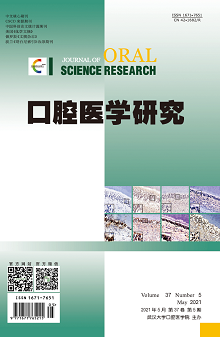|
|
Effect of Overexpression of ADAM10 on Osteogenic Differentiation of Periodontal Ligament Stem Cells by Regulating Notch Signaling Pathway
ZHU Yongcui, ZHAI Lei, YAN Yazi, LI Yaru
2021, 37(5):
468-473.
DOI: 10.13701/j.cnki.kqyxyj.2021.05.018
Objective: To investigate the effect of a disintegrin and metalloproteas 10 (ADAM10) on the osteogenic differentiation of human periodontal stem cells (hPDLSCs). Methods: hPDLSCs were cultured in vitro and osteogenic differentiation was induced. The mRNA expression levels of ADAM10 in the 0, 7, and 14 d of osteogenic induction were detected by RT-PCR. hPDLSCs were infected with ADAM10 overexpressed lentivirus, and the cells were divided into blank control group, no-load group, and ADAM10 overexpressed group. The levels of ADAM10 mRNA and protein expression in hPDLSCs after infection were detected by RT-PCR and Western blotting, respectively. CCK-8 was used to detect cell proliferation in each group. After osteogenic differentiation of infected hPDLSCs, alizarin red staining was performed to observe the formation of mineralized nodules in each group. The mRNA levels of osteogenic genes (ALP, Runx2, and OCN) and Notch signaling pathway related genes (Notch1, NICD, and Hes1) were detected by RT-PCR, and protein expressions of Notch signaling pathway related genes (Notch1, NICD, and Hes1) were detected by Western blot. Results: The mRNA expression level of ADAM10 decreased gradually in hPDLSCs during day 0, 7, and 14 of osteogenic differentiation (P<0.05). After infected with ADAM10 overexpressed lentivirus, the mRNA and protein expression levels of ADAM10 in hPDLSCs were significantly increased (P<0.05), and cell proliferation capacity was significantly enhanced (P<0.05). After osteogenic differentiation, compared with the control group and the no-load group, the mineralized nodule formation, mRNA expression levels of ALP, Runx2, and OCN, and protein expression levels of Notch1, NICD, and Hes1 in the ADAM10 overexpression group were significantly decreased (P<0.05). Conclusion: ADAM10 overexpression can promote the proliferation and inhibit the osteogenic differentiation of hPDLSCs, which may be related to the activation of Notch signaling pathway
References |
Related Articles |
Metrics
|

